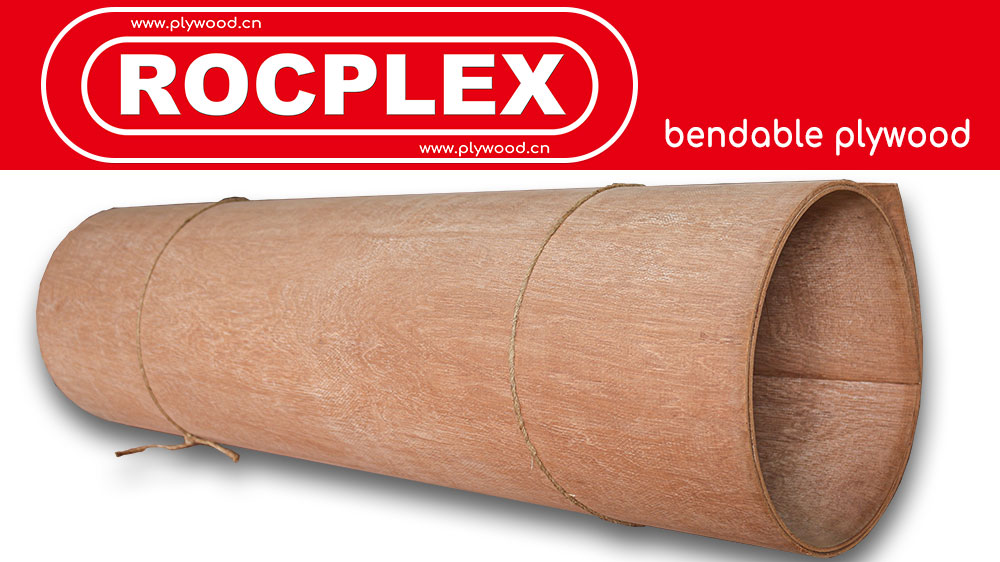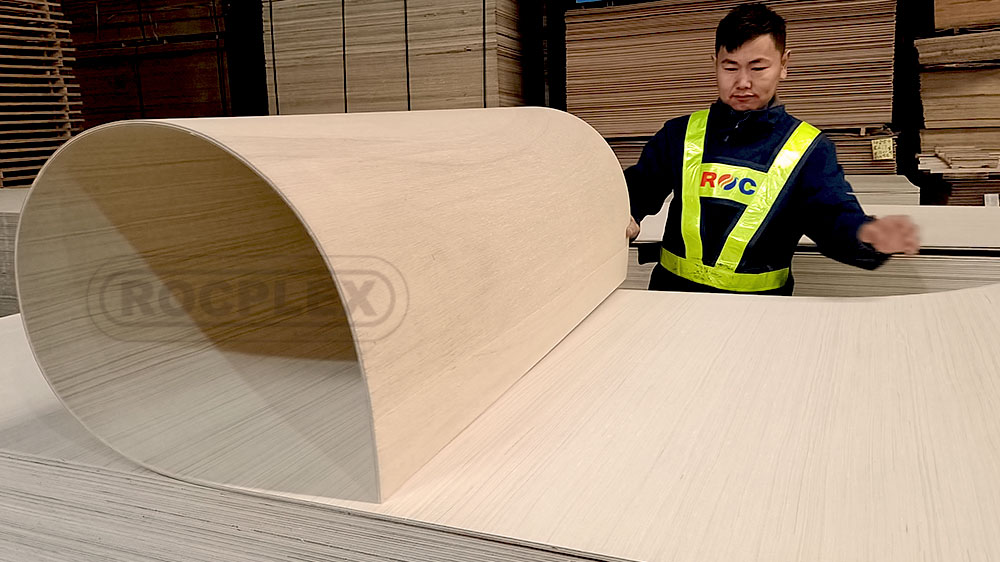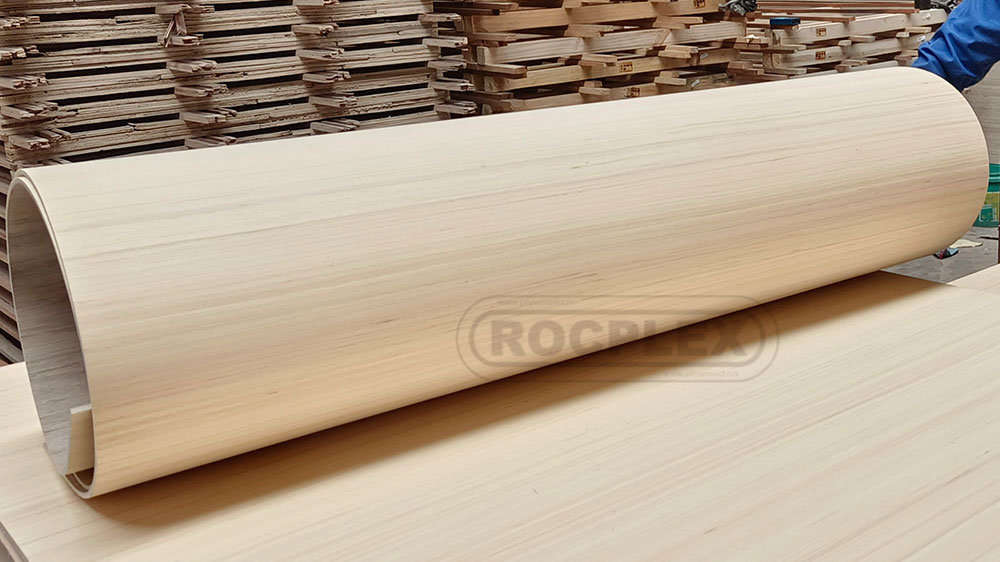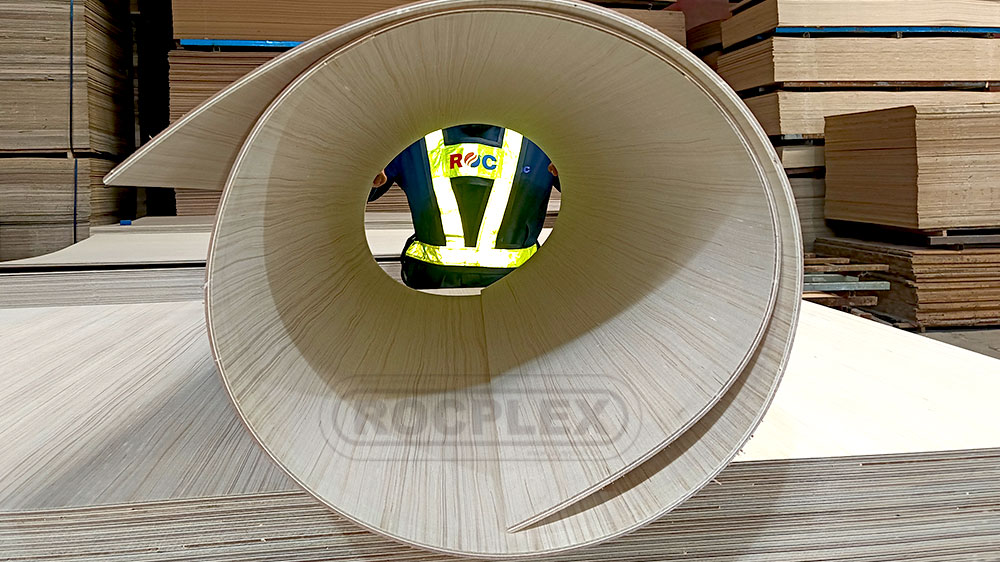What is Flexible Plywood?
Flexible plywood, often referred to as bendable plywood or bending plywood, is a specialized form of plywood that can be easily bent without cracking. This type of plywood is made by layering thin veneers of wood in a way that gives it remarkable flexibility. It allowing it to be shaped into various forms that traditional plywood cannot achieve. It’s a breakthrough in the woodworking and construction industries, offering unparalleled versatility in applications ranging from furniture design to architectural structures.

The Manufacturing Process
The secret behind the flexibility of this plywood lies in its manufacturing process. Unlike standard plywood, flexible plywood is made by arranging the grain of each layer perpendicular to the previous one. This cross-graining technique not only provides strength but also allows the wood to bend. Additionally, manufacturers often use softer wood species and apply less adhesive between layers to enhance the bending capacity.
Unique Properties
Flexible plywood stands out for its unique properties. It is exceptionally pliable, yet maintains the strength and durability characteristic of traditional plywood. This balance of flexibility and strength opens up new possibilities for intricate designs and shapes, which were previously challenging or impossible to achieve with standard wood materials.
Advantages Over Traditional Materials
One of the key advantages of flexible plywood is its ability to create smooth curves and complex shapes without the need for cutting or jointing. This not only simplifies the construction process but also results in a more aesthetically pleasing and seamless finish. Additionally, its lightweight nature makes it easy to handle and transport, a significant benefit in large-scale construction projects.
Applications in Modern Design
The versatility of flexible plywood has made it a favorite among architects, interior designers, and furniture makers. Its ability to bend makes it ideal for creating curved structures such as arches, columns, and sculptural forms. In furniture design, it allows for the creation of ergonomic and organic shapes, adding both functionality and style to pieces.
Architectural Innovations
In architecture, flexible plywood has enabled the creation of fluid and dynamic structures that challenge traditional building forms. It is commonly used for decorative interior elements like curved walls, ceilings, and built-in furniture, adding a unique dimension to spaces.
Furniture Design Breakthroughs
Furniture designers have embraced flexible plywood for its ability to produce sleek, curved lines in chairs, tables, and cabinetry. The material’s bendability allows for ergonomic designs that conform more naturally to the human body, enhancing comfort and appeal.
Sustainability and Environmental Impact
Flexible plywood is not only innovative in design but also in sustainability. Many manufacturers prioritize the use of sustainably sourced wood and eco-friendly adhesives, making it a responsible choice for environmentally conscious projects. Its durability also means that products made with flexible plywood have a longer lifespan, reducing the need for frequent replacements and thereby lessening environmental impact.
Challenges and Solutions
While flexible plywood offers numerous advantages, it also presents some challenges. For instance, its flexibility can sometimes reduce structural strength, necessitating additional support in certain applications. Manufacturers have addressed this by developing hybrid products that combine the flexibility of bendable plywood with the strength of traditional materials.
Embracing Flexibility in Design
Flexible plywood is more than just a building material; it represents a shift in the way we think about design and construction. Its ability to bend and shape to our creative will opens up a realm of possibilities, from innovative architectural structures to ergonomic furniture designs. As we continue to explore its potential, flexible plywood stands as a testament to human ingenuity and the ever-evolving nature of design.
Transforming Interior Spaces with Flexible Plywood
The impact of flexible plywood extends beyond structural applications; it’s revolutionizing interior design. Its ability to form fluid, organic shapes enables designers to create more engaging, dynamic spaces. This adaptability is particularly valuable in small or irregularly shaped areas, where traditional materials might be limiting.
Customization and Personalization
One of the most significant advantages of bending plywood is the level of customization it offers. Designers can tailor the material to specific dimensions and shapes, allowing for a high degree of personalization in projects. This flexibility makes it an ideal choice for bespoke furniture or unique architectural features that require a specific curvature or form.
Acoustic Properties
In addition to its visual appeal, bending plywood also boasts excellent acoustic properties. Its ability to be molded into curved surfaces helps in diffusing sound, making it a popular choice in auditoriums, concert halls, and other spaces where sound quality is paramount. The material’s natural wood composition also contributes to a warmer, more inviting acoustic environment compared to traditional building materials.
Bridging the Gap Between Aesthetics and Functionality
Flexible plywood is not just about aesthetics; it’s also about enhancing functionality. Its unique properties allow for the creation of spaces that are not only visually appealing but also more ergonomic and user-friendly.
Ergonomic Design
In furniture design, the flexibility of this plywood facilitates the creation of pieces that conform to the human body, offering enhanced comfort and support. This ergonomic aspect is particularly beneficial in seating and workspace design, where comfort directly impacts user well-being and productivity.
Maximizing Space Utilization
The material’s ability to be molded into various shapes also plays a crucial role in maximizing space utilization. Curved and seamless designs can be integrated into corners and other underutilized spaces, making it an excellent solution for compact urban living environments.

Challenges in Working with Flexible Plywood
While flexible plywood offers a myriad of benefits, it also presents certain challenges in application. Its unique properties require a different approach compared to traditional materials.
Specialized Skills and Techniques
Working with flexible plywood often demands specialized skills and techniques. The material’s flexibility, while an advantage, also means that it can be more challenging to cut, join, and finish. Craftsmen and builders need to be familiar with the specific properties of flexible plywood to ensure successful implementation in projects.
Cost Considerations
Another factor to consider is cost. Flexible plywood can be more expensive than standard plywood due to its specialized manufacturing process. However, this cost is often offset by the material’s versatility and the unique design possibilities it offers.
Conclusion: A Material Shaping the Future
Flexible plywood is a material that embodies innovation and creativity. Its unique blend of aesthetics and functionality is pushing the boundaries of what is possible in design and construction. As we continue to explore and understand its full potential, flexible plywood is set to remain a key player in the future of architecture and design.
The Global Impact of Flexible Plywood
Flexible plywood’s influence extends globally, impacting various industries and cultures. Its versatility and adaptability make it a universal material, suitable for diverse climates and cultural aesthetics. This global appeal is crucial in a world increasingly focused on sustainable and adaptable design solutions.
Cross-Cultural Design Integration
The adaptability of flexible plywood allows it to blend seamlessly into different architectural and design styles, from minimalist Scandinavian designs to more ornate Asian aesthetics. This versatility ensures that it can meet a wide range of cultural preferences and requirements, making it a universally appealing material.
Impact on Global Sustainability Efforts
In the context of global sustainability efforts, flexible plywood plays a significant role. Its potential for being sourced from sustainably managed forests makes it an eco-friendly choice. Furthermore, the efficiency in its use, with minimal wastage due to its bendable nature, aligns well with global efforts to reduce environmental impact in the building and design sectors.
Technological Advancements and Future Prospects
The future of flexible plywood looks bright, with ongoing technological advancements enhancing its properties and expanding its applications. Innovations in manufacturing techniques and material science are continuously improving the quality, durability, and sustainability of this versatile material.
Innovations in Material Science
Advancements in adhesives and treatments are making flexible plywood more durable and resistant to environmental factors such as moisture and temperature fluctuations. These improvements are expanding the range of climates and settings in which it can be effectively used.
Digital Design and Fabrication
The integration of digital design tools and computer-aided manufacturing processes is opening up new possibilities for flexiply. These technologies allow for precise control over the bending and shaping process, enabling the creation of more complex and intricate designs.
FAQs: Understanding Flexible Plywood
As we conclude, let’s address some frequently asked questions about flexible plywood to provide a deeper understanding of this innovative material.
Which Plywood is Most Flexible?
The flexibility of plywood depends on the thickness of the veneers and the type of wood used. Generally, thinner veneers and softer wood species result in more flexible wood.
What are the Properties of Flexible Plywood?
Key properties include high flexibility, strength, lightweight nature, and the ability to be shaped into smooth curves and complex forms.
How is Flexible Plywood Made?
It’s made by layering thin wood veneers with the grain of each layer arranged perpendicular to the previous one, often using softer wood species and less adhesive to enhance flexibility.
What is the Disadvantage of Flexi Ply?
The main disadvantage is that it can be more expensive than regular plywood and may require specialized skills for proper handling and installation.
How is Flexi Ply Different to Plywood?
Unlike standard plywood, flexi ply is designed for bending and shaping into curved forms, making it ideal for applications where traditional plywood is too rigid.

Embracing a Flexible Future in Design
In conclusion, flexible plywood is not just a material; it represents a paradigm shift in design and construction. Its ability to bend to the will of creators has ushered in a new era of architectural and design possibilities. As we continue to explore its potential, bending plywood stands as a testament to human ingenuity and the dynamic nature of material science. Its role in sustainable design further solidifies its position as a key material in shaping the future of our built environment. With continued innovation and exploration, bendable plywood will undoubtedly play a pivotal role in the evolution of design and architecture for years to come.
Post time: Jan-12-2024


